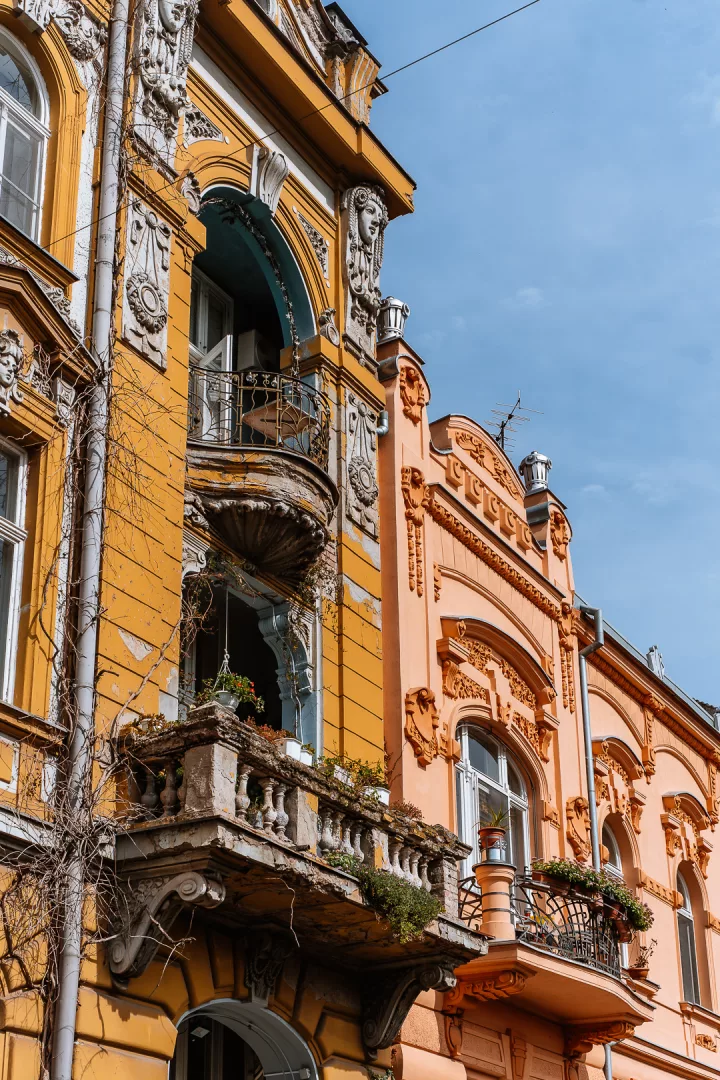During my stay in Croatia, I visited my friends who live in Osijek and they showed me around this city. My last visit was such a long time ago that I barely remembered it. So during that long weekend, I spent one day discovering Art Nouveau buildings in Osijek. Or as it’s more often called in Croatia, the Secession movement. This Viennese branch of Art Nouveau thrived from 1897 to 1914 and influenced a portion of Croatian architecture.


But first off, let’s begin with Osijek, the fourth largest city in Croatia. It’s the biggest city in Slavonia, the region in eastern Croatia. In fact, that’s the same region where my hometown of Požega is situated. After a 90-minute bus ride, I finally arrived in Osijek. Unlike my usual city visits, this one was much more relaxed. I focused on spending time with friends and only taking photos whenever we ventured outside together. One long walk in particular covered most of the notable Art Nouveau palaces scattered throughout Osijek.

Villa Mimi
Ulica Stjepana Radića 23, 31000
Formerly known as Villa Batory, Villa Mimi was a sanatorium and a hospital before closing and being abandoned for twenty years. Luckily, new owners restored it and it is now available for rent. In fact, this is one of the most famous buildings in the entire city!

Kastenbaum-Korsky Palace
Europska avenija 16, 31000
Built in 1905 in a Viennese Secession style, the Kastenbaum-Korsky Palace is one of the many distinguished buildings on European Avenue in Osijek. Regarded as the most beautiful street in the city, it has a string of Secession palaces and houses. This palace was a project by Ferenc Ficher, a notable Hungarian architect.

Sauter Palace
Europska avenija 18, 31000
Another imposing building on the famous European Avenue, Sauter Palace was the private residence of a local lawyer. It dates back to 1905 and perfectly represents the Viennese Secession.

Post Office
Ulica Kardinala Alojzija Stepinca 17, 31000
This magnificent building still houses the post office and dates back to 1912. It’s an example of Hungarian Art Nouveau designed by Ivan Lay. Unfortunately, it suffered significant damage during the war and is still awaiting restoration. The local post office still operates from here and I found myself wishing it wasn’t Sunday because I wanted to see its interior!

Kuća Dekulić-Plavšić
Europska avenija 10, 31000
Dating back to 1906, the House Sekulić-Plavšić has a unique uneven floorplan. Designed by Wilhelm Carl Hofbauer, it’s got all the standard Art Nouveau elements. An open layout and endless floral and ornamental details. My favorite part was the circular balcony on the corner of the building!

House Spitzer
Europska avenije 14, 31000
Another private residence from 1905, House Spitzer stands out with its vibrant facade. My favorite aspect of it is the big central window lined with a beautiful iron fence.

Aside from the Art Nouveau architecture, there’s much more to see in Osijek. For example, Tvrđa (citadel) is the old town of the city. It’s an ensemble of Baroque architecture and a fort next to the river. Nowadays, you’ll find many educational and university buildings in this part of the city.


During my long weekend in Osijek, we spent one full day in Subotica. This beautiful town in Serbia was an ideal continuation of the Art Nouveau theme. It’s also the perfect day trip from Osijek! There are even more nearby destinations for day trips, most of them nature-related.

Osijek has an interesting vibe to it where it feels equally metropolitan and quaint. Also, the restaurant scene is surprisingly varied, focusing on regional specialties. The city is pedestrian-friendly and perfect for long strolls. It made for an interesting visit and an escape from the lazy routine I was enjoying in my hometown. All I know is that I’ll have to return for a longer stay and explore more of Osijek and its surroundings!


Brigita Soldo
Travel Photographer · Creative Content Creator · Vintage & Sustainable Fashion Advocate